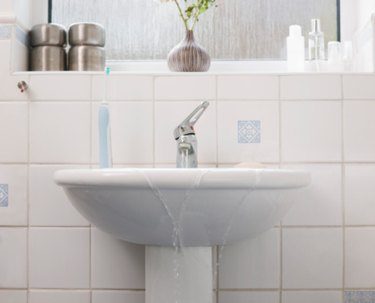
Lavatory sink overflow drains provide a vital function, keeping the water in the lavatory from overflowing if you leave the sink unattended while filling it up. Learning how your overflow drain works will help you understand the potential problem of installing an incompatible drain in the lavatory as well as the consequences of clogs in the overflow drain.
Location
Video of the Day
A sink's overflow drain opening sits near the top of the sink at what some call the high water mark in the sink. Commonly, sink overflow drain openings sit opposite the sink's faucet in a place where you normally do not see the opening unless you're bending over the sink or looking into a mirror above the sink. Some sink overflow drains consist or just one hole while others have several smaller holes in a row.
Video of the Day
Function
A sink's overflow drain functions much like the main drain in the sink. When the water level reaches the overflow drain's opening, the water simply starts flowing into the drain opening. Rather than having a stopper, the overflow drain opening always stays open, ensuring it will operate at any given moment. The water flows into the opening and down a tube concealed below the sink's surface, which leads the water to the main drainpipe in the sink. The water then drains the same way as water that flows down the main drain in the sink.
Drainpipe Hookup
Not all sinks come with an overflow drain system, so if your sink has an overflow system, you must use a drain piece that has a receptor for overflow drain systems. The receptor consists of extra holes in the sink's drain, which line up with the hole on the other end of the overflow drain system. If your sink's drain is not compatible with overflow drains, the overflow drain will back up and the sink will spill over.
Clogs
Like any other drain, a lavatory sink's overflow drain system will develop clogs. Even if you do not use the overflow drain often, you need to test it periodically to avoid problems with its function when you experience an emergency with your sink. If you find that your overflow drain is backing up, pour several cups of bleach down the overflow drain opening to clear out any buildup in the system. Other options, such as snaking or plunging the overflow drain, will not work the same way as on the lavatory's main drain.